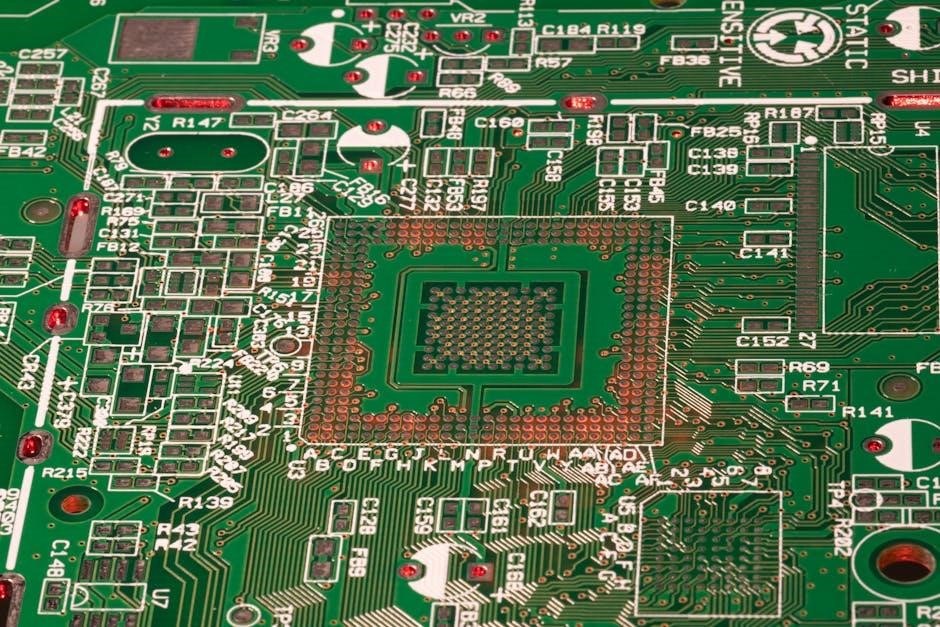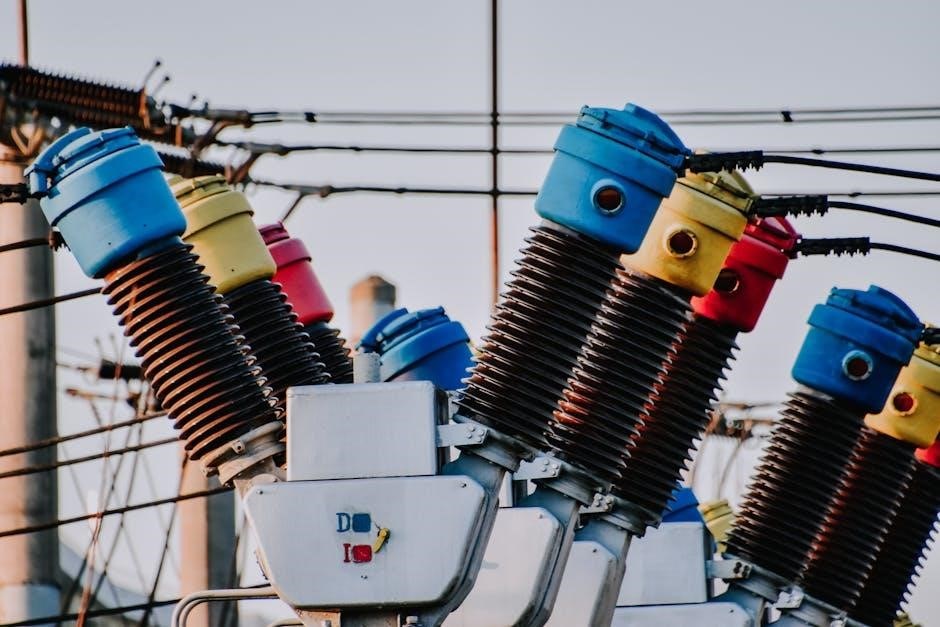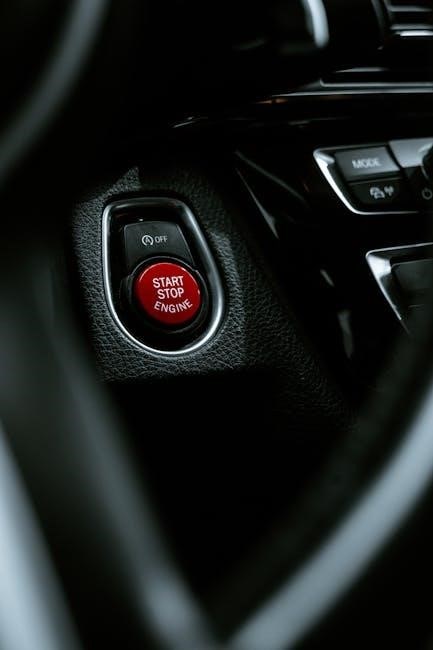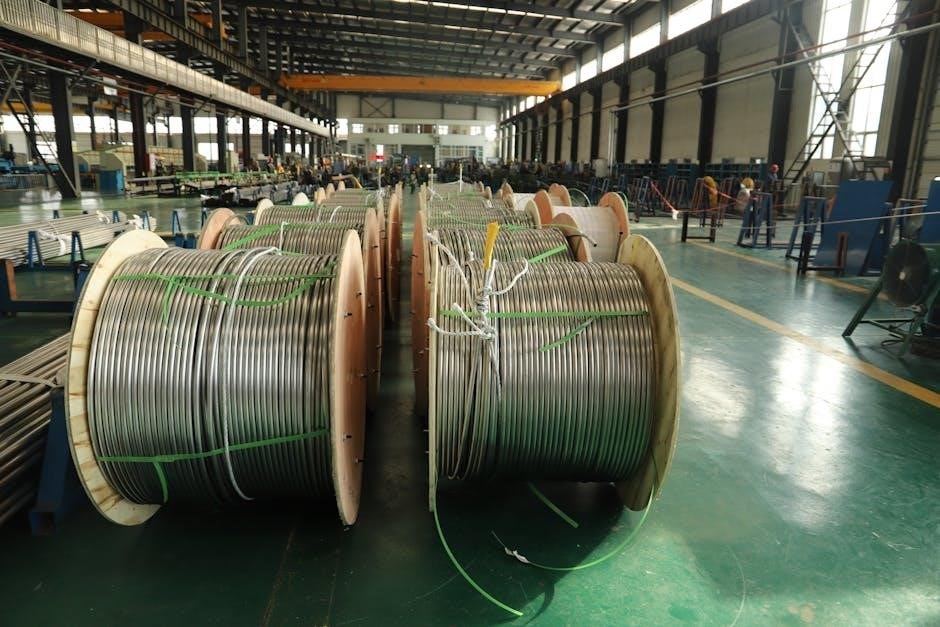The 1966 Chevelle ignition system is a critical component of the vehicle’s engine operation‚ relying on the ignition coil to generate the high voltage needed for spark plugs.
Overview of the 1966 Chevrolet Chevelle
The 1966 Chevrolet Chevelle is a classic American muscle car known for its powerful engine options and sleek design. It was offered in various body styles‚ including sedans‚ coupes‚ and convertibles‚ catering to a wide range of buyers. The Chevelle featured a robust lineup of V8 engines‚ with displacements ranging from 283 cubic inches to 396 cubic inches‚ delivering impressive performance for its time. Its popularity among car enthusiasts has endured‚ making it a favorite for restoration projects; The availability of detailed wiring diagrams‚ such as the 1966 Chevelle ignition coil wiring diagram‚ has simplified modifications and repairs‚ ensuring the Chevelle remains a beloved choice for both collectors and DIY mechanics.
Importance of the Ignition Coil in the Chevelle Engine
The ignition coil plays a pivotal role in the 1966 Chevelle’s engine‚ serving as the heart of the ignition system. It converts the battery’s low voltage into the high voltage required by the spark plugs to ignite the fuel-air mixture. A malfunctioning ignition coil can lead to poor engine performance‚ reduced power‚ and decreased fuel efficiency. Proper installation and wiring‚ as detailed in the 1966 Chevelle ignition coil wiring diagram‚ ensure optimal functionality. Regular maintenance and upgrades‚ such as installing an HEI distributor‚ can enhance reliability and performance‚ making the ignition coil a critical component for both classic and modified Chevelle engines.

Understanding the Ignition Coil Wiring Diagram
The ignition coil wiring diagram guides the connection of the pink (12V ignition) wire to the coil‚ ensuring proper voltage supply. Installing capacitors and grounding ensures system stability and prevents interference.
Key Components of the Ignition System
The 1966 Chevelle ignition system comprises essential components like the ignition coil‚ distributor‚ spark plugs‚ and wiring harness. The pink wire provides a 12V ignition feed‚ while capacitors ensure voltage stability and prevent interference. Proper grounding is crucial for system reliability‚ and the ballast resistor regulates coil voltage. The ignition switch activates the circuit‚ and the distributor cap directs spark to cylinders. These components work together to ensure efficient engine operation and reliable ignition.
Reading and Interpreting the Wiring Diagram
The wiring diagram for the 1966 Chevelle ignition system is essential for understanding the circuit layout and connections. It illustrates the flow of electricity from the ignition switch to the coil‚ distributor‚ and spark plugs. Key elements include the pink wire‚ which supplies 12V ignition power‚ and the black/fabric wire connected to the ballast resistor. Capacitors are shown to filter voltage spikes‚ ensuring stable operation. Grounding points are highlighted to maintain proper circuit function. By tracing each wire and identifying components‚ enthusiasts can diagnose issues or install upgrades like HEI distributors. Proper interpretation ensures accurate connections and reliable ignition system performance.

Tools and Materials Needed
Essential tools include wire cutters‚ pliers‚ and a multimeter. Materials required are ignition coil‚ spark plug wires‚ and connectors. Ensure all components are compatible with the Chevelle’s specifications.

Basic Tools for Wiring Diagram Installation
To install the ignition coil wiring diagram correctly‚ you’ll need a set of basic tools. These include wire cutters for trimming wires‚ pliers for crimping connectors‚ and a multimeter to test voltage and continuity. A soldering iron may also be necessary for creating secure connections. Ensure you have a well-lit workspace and a diagram to reference. Additional tools like screwdrivers and wrenches may be required for accessing components. Having the right tools ensures a smooth and accurate installation process‚ preventing potential errors and ensuring the ignition system functions properly. Always use high-quality tools to avoid damaging the wiring or components. Proper preparation is key to a successful installation.
Essential Materials for the Ignition System
The 1966 Chevelle ignition system requires specific materials for proper installation and functionality. Key components include the ignition coil‚ distributor cap‚ spark plug wires‚ and the wiring diagram itself. Ensure you have a high-quality wiring harness designed for your Chevelle’s specific model. Additional materials like capacitors may be needed to reduce electrical noise. A ballast resistor is often necessary to regulate voltage to the coil. Proper grounding materials‚ such as copper straps or grounding wires‚ are crucial to prevent voltage drops. Always use high-quality‚ heat-resistant wires and connectors to ensure reliability. Having all necessary materials on hand will streamline the installation process and ensure optimal performance of the ignition system.

Step-by-Step Installation Guide
Mount the ignition coil securely‚ ensuring proper alignment with the distributor. Route the pink (12V ignition) wire to the coil‚ trimming excess length. Connect the black wire to the distributor terminal‚ ensuring all connections are tight. Use the wiring diagram to verify accuracy. Install capacitors on the coil and alternator for noise reduction. Ensure all grounds are clean and secure. Double-check all connections before starting the engine to avoid potential issues.
Connecting the Ignition Coil to the Distributor
The ignition coil connects to the distributor via the black wire‚ which provides the signal for spark generation. Route the pink (12V ignition) wire from the ignition switch to the coil’s positive terminal. For HEI distributors‚ ensure the pink wire is securely connected to the coil’s positive post. Trim excess wire length to avoid interference. Connect the black wire to the distributor’s side terminal‚ ensuring a snug fit. If using an after-market ignition system‚ refer to the wiring diagram for specific connections. Double-check all terminals for tightness and proper alignment. This setup ensures proper voltage supply and spark distribution to the engine cylinders. Always consult the wiring diagram for accuracy.
Wiring the Pink (12V Ignition) Wire
The pink wire‚ designated as the 12V ignition wire‚ plays a crucial role in powering the ignition system. Begin by routing the pink wire from the ignition switch to the ignition coil. If your Chevelle is equipped with an HEI distributor or an after-market ignition system‚ connect the pink wire directly to the positive terminal of the coil. Ensure the connection is secure and free from any interference. Trim the wire to the appropriate length to maintain a clean installation. Properly insulate any splices or connections to prevent voltage loss. This step ensures consistent power supply to the ignition coil‚ which is essential for reliable engine operation. Always refer to the wiring diagram for precise connections.

Advanced Modifications and Upgrades
Upgrading the ignition system enhances performance and reliability. Consider installing an HEI distributor for improved spark output and easier wiring. After-market ignition systems offer advanced features like programmable timing and higher voltage output‚ modernizing your Chevelle’s engine. These upgrades ensure better fuel efficiency and smoother operation.
HEI Distributor Installation and Wiring
Installing an HEI distributor on your 1966 Chevelle enhances spark quality and reliability. Start by disconnecting the battery to prevent electrical shocks. Remove the old distributor‚ marking the spark plug wires for proper reconnection. Mount the HEI distributor‚ ensuring it aligns with the engine’s timing marks. The HEI’s internal coil simplifies wiring—connect the pink 12V ignition wire directly to the distributor’s ignition terminal. Route wires neatly‚ avoiding heat sources. Use the provided wiring diagram to ensure all connections are correct. After installation‚ reconnect the spark plug wires and test the system by starting the engine and monitoring for smooth operation.
After-Market Ignition System Integration
Integrating an after-market ignition system into your 1966 Chevelle enhances performance and reliability. Begin by reviewing the wiring diagram to ensure compatibility with your existing setup. Connect the pink (12V ignition) wire directly to the after-market ignition coil or module‚ following the manufacturer’s instructions. Install capacitors on the ignition coil and alternator to reduce electrical interference. Ensure all connections are secure and properly grounded to avoid malfunctions. Route wires away from heat sources and sensitive electronics. After installation‚ test the system by starting the engine and monitoring for smooth operation. This upgrade offers improved spark quality and consistent engine performance.

Troubleshooting Common Issues
Troubleshooting common issues involves checking for faulty connections‚ testing the ignition coil’s resistance‚ and verifying wiring against the diagram to ensure proper spark delivery.
Identifying and Repairing Faulty Connections
Faulty connections in the ignition system can cause misfires or engine failure. Start by inspecting wires for signs of wear or damage. Check the pink ignition wire connecting to the coil‚ ensuring it’s securely attached and free from corrosion. Use the wiring diagram to verify all connections match the specified routes. If a wire is damaged‚ replace it with the correct gauge and color to maintain consistency. Clean or replace corroded terminals‚ and ensure all connections are tight. Testing continuity with a multimeter can help identify breaks in the wiring. Properly grounding components is crucial for reliable spark generation. Always refer to the diagram to avoid mismatches during repairs.

Resolving Ignition Coil Malfunctions
Ignition coil malfunctions can cause a range of issues‚ including no spark‚ inconsistent firing‚ or complete engine failure. Begin by checking the coil’s primary and secondary resistance using a multimeter‚ comparing readings to the manufacturer’s specifications. Ensure the pink ignition wire is securely connected to the coil and free from damage. If the coil is faulty‚ replace it with a high-quality unit compatible with your Chevelle’s system. Always refer to the wiring diagram to confirm proper connections and avoid wiring mismatches. After installation‚ test the system to ensure the spark is consistent and strong. Proper grounding and clean connections are essential for optimal performance.

Safety Precautions and Best Practices
Always ensure proper grounding of components to prevent electrical damage or fire hazards. Install capacitors on the ignition coil and alternator for stable voltage regulation.
Keep all wiring away from high-temperature areas and moving parts. Use proper tools and follow the wiring diagram to avoid short circuits or misconnections.
Relocate the ignition coil and associated wiring away from sensitive electronics to minimize interference. Regularly inspect connections for cleanliness and security to maintain system reliability.
Ensuring Proper Grounding and Safety
Proper grounding is essential for the 1966 Chevelle ignition system to function safely and efficiently. Always ensure that all components‚ including the ignition coil and alternator‚ are securely grounded.
Install capacitors on the ignition coil and alternator to stabilize voltage and prevent electrical interference. Keep all wiring away from high-temperature areas and moving parts to avoid damage or fire hazards.
Use proper tools and follow the wiring diagram to avoid short circuits or misconnections. Regularly inspect all connections for cleanliness and tightness to maintain system reliability and safety.
Grounding ensures proper current flow and protects against electrical shocks or component failure. Always prioritize safety when working with electrical systems to avoid accidents or damage.
Avoiding Common Mistakes in Wiring
When wiring the 1966 Chevelle ignition system‚ avoid common mistakes to ensure proper functionality and safety.
Incorrect routing of the pink (12V ignition) wire can lead to system malfunctions. Always route it directly to the ignition coil and trim to the correct length.
Misconnecting the trinary switch or failing to follow the wiring diagram can cause ignition failures. Double-check all connections before starting the engine.
Overlooking the installation of capacitors on the ignition coil and alternator can result in voltage fluctuations and electrical interference.
Ensure all wiring is kept away from heat sources and moving parts to prevent damage. Properly securing wires and connectors will prevent future issues.
Adhering to the wiring diagram and manufacturer instructions is crucial for a reliable ignition system.

Additional Resources and References
For detailed guidance‚ consult the 1966 Chevrolet Chevelle wiring diagram manual‚ which provides comprehensive instructions and technical specifications.
Online forums and communities‚ such as Classic Muscle Restoration Parts‚ offer extensive support and resources for ignition system modifications and repairs.
Recommended Manuals and Guides
The 1966 Chevrolet Chevelle wiring diagram manual is an essential resource‚ offering detailed instructions for ignition system installation and troubleshooting.
This manual includes comprehensive technical specifications‚ component layouts‚ and step-by-step guides for both stock and modified setups.
Additionally‚ MSD Ignition manuals provide advanced insights for aftermarket upgrades‚ ensuring compatibility and optimal performance.
These resources are invaluable for DIY enthusiasts and professionals alike‚ covering everything from basic wiring to complex system integration.
By referencing these guides‚ users can ensure accurate and safe modifications‚ adhering to manufacturer standards and best practices.
Online Communities and Forums for Support
Online forums and communities are invaluable for troubleshooting and modifying the 1966 Chevelle ignition system. After completing the ignition system installation‚ conduct a thorough inspection to ensure all connections are secure and properly routed. Verifying the installation ensures the ignition system functions correctly and safely. Testing the ignition system ensures proper functionality and identifies potential issues.
Popular platforms like Chevy Talk and 67-72ChevyTruck host active discussions‚ offering wiring diagrams‚ installation tips‚ and expert advice.
Members often share personal experiences‚ making it easier to diagnose issues or plan upgrades.
These communities are particularly useful for enthusiasts working on custom setups or integrating aftermarket components.
Additionally‚ specialized forums focus on classic Chevrolet models‚ ensuring tailored support for the 1966 Chevelle.
Engaging with these resources can save time and ensure a successful ignition system installation or modification.
They are a testament to the vibrant and knowledgeable automotive community dedicated to preserving and enhancing classic vehicles.
Verify the wiring diagram matches the physical setup‚ and test the ignition coil for proper function.
A successful installation will result in reliable engine performance and optimal spark delivery.
Final checks ensure safety and prevent potential malfunctions‚ guaranteeing a smooth driving experience.Verifying the Installation
Begin by checking all wiring connections against the diagram‚ ensuring the pink (12V ignition) wire is securely connected to the coil.
Inspect the distributor cap and spark plug wires for proper placement and condition.
Next‚ test the ignition system by starting the engine and monitoring for consistent spark and smooth operation.
Use a spark tester to confirm spark at each cylinder‚ verifying each spark plug wire delivers a strong‚ consistent spark.
Check for any signs of arcing or loose connections‚ which could indicate improper installation or wear.
Finally‚ ensure the ignition coil’s power and ground wires are securely attached to prevent voltage drops or intermittent issues.
This thorough verification process guarantees a reliable ignition system and optimal engine performance.Testing the Ignition System
Start by turning the ignition key to the “on” position and observing the dashboard warning lights.
Use a multimeter to measure the voltage at the ignition coil‚ ensuring it receives the correct 12V supply.
With the engine running‚ listen for any unusual noises or misfires‚ which could indicate faulty spark plugs or wires.
Employ a spark tester to verify spark at each cylinder‚ ensuring the ignition coil is firing correctly.
Check the distributor cap for cracks or wear‚ and ensure the rotor spins freely.
If using an HEI distributor‚ confirm the pink wire is correctly routed and connected to the coil.
Testing each component systematically guarantees a reliable ignition system and optimal engine performance.
